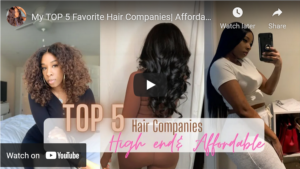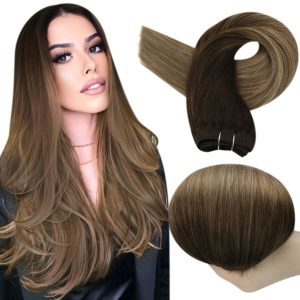Hair Extensions 101: The Basics You Need to Know
Are you looking to add length, volume, or texture to your hair? Hair extensions can be an excellent option to achieve the desired look. Hair extensions come in various types, styles, and lengths, making it easy to find the perfect match for your hair. In this article, we will provide you with everything you need to know about hair extensions, from the different types to how to care for them. Let’s get started.
Table of Contents
- What Are Hair Extensions?
- Types of Hair Extensions
- Clip-In Extensions
- Tape-In Extensions
- Sew-In Extensions
- Fusion Extensions
- Micro Link Extensions
- How to Choose the Right Hair Extension
- How to Apply Hair Extensions
- How to Care for Hair Extensions
- Common Mistakes to Avoid with Hair Extensions
- Frequently Asked Questions (FAQs)
What Are Hair Extensions?
Hair extensions are additional hair that is added to your existing hair to give it length, volume, or texture. Hair extensions can be made of natural human hair or synthetic fibers, depending on your preferences and budget. They can be clipped, taped, sewn, or fused onto your natural hair, creating a seamless look that can last for several months.
Types of Hair Extensions
There are several types of hair extensions available in the market, each with its own unique benefits and drawbacks. Here are the most common types of hair extensions:
Clip-In Extensions
Clip-in hair extensions are the most popular type of hair extensions as they are easy to use and affordable. They come in a set of wefts, each with small clips attached to them. You can clip these extensions onto your natural hair, adding length and volume instantly. They are also easy to remove, making them an excellent option for those who want to switch up their hair frequently.
Tape-In Extensions
Tape-in extensions are semi-permanent hair extensions that are attached to your natural hair using adhesive tape. They lay flat against your head, creating a natural look. They can last for several months, depending on how well you take care of them.
Sew-In Extensions
Sew-in extensions involve braiding your natural hair into cornrows and then sewing the hair extensions onto the braids. This method is ideal for those who want to add volume and length to their hair. They can last for several months, but they require maintenance to avoid matting and tangling.
Fusion Extensions
Fusion hair extensions involve attaching hair extensions to your natural hair using a keratin glue. The glue is melted and then fused onto your natural hair, creating a bond that can last for several months. This method is ideal for those who want a seamless look and are willing to spend more on their hair extensions.
Micro Link Extensions
Micro link extensions, also known as micro bead extensions, involve attaching hair extensions to your natural hair using small beads or rings. The beads are clamped onto your natural hair, creating a bond that can last for several months. This method is ideal for those who want a natural look without using glue or braids.
How to Choose the Right Hair Extension
Choosing the right hair extension can be overwhelming, but it doesn’t have to be. Here are some factors to consider when selecting the right hair extension:
- Budget: Hair extensions can range from affordable to expensive, depending on the quality and type.
- Hair Texture: Choose hair extensions that match your hair texture to create a seamless look.
- Lifestyle: Choose hair extensions that fit your lifestyle. For example, clip-in extensions may be ideal for those who want to switch up their hair frequently.
- Hair Color: Choose hair extensions that match your hair color to create a natural look
How to Apply Hair Extensions
Once you have chosen the right hair extension, the next step is to apply them correctly. The application process may vary depending on the type of hair extension you have chosen, but here are some general steps to follow:
- Prepare your natural hair by washing and conditioning it. Make sure your hair is completely dry before applying the hair extensions.
- Separate a section of your hair where you want to apply the hair extension. Clip the remaining hair out of the way.
- If you are using clip-in hair extensions, open the clips and attach them to the roots of your hair. Make sure the clips are secure and comfortable.
- If you are using tape-in hair extensions, remove the backing from the adhesive tape and attach the weft to your natural hair. Press firmly to make sure the tape adheres to your hair.
- If you are using sew-in hair extensions, have a professional stylist braid your natural hair into cornrows and then sew the wefts onto the braids.
- If you are using fusion or micro link hair extensions, have a professional stylist attach the extensions to your natural hair using the appropriate technique.
- Once all the hair extensions are applied, style your hair as desired.
How to Care for Hair Extensions
Proper care is essential to maintain the quality and longevity of your hair extensions. Here are some tips for caring for your hair extensions:
- Wash your hair extensions gently using sulfate-free shampoo and conditioner.
- Avoid using hot tools on your hair extensions, as they can damage the hair fibers.
- Brush your hair extensions regularly using a soft-bristled brush or a wide-toothed comb.
- Avoid sleeping with wet hair extensions, as this can cause tangling and matting.
- Be gentle when brushing or styling your hair extensions, as rough handling can damage the hair fibers.
Common Mistakes to Avoid with Hair Extensions
There are several common mistakes that people make when wearing hair extensions. Here are some mistakes to avoid:
- Choosing the wrong type of hair extension for your hair.
- Applying the hair extensions incorrectly.
- Failing to properly care for your hair extensions.
- Using hot tools on your hair extensions.
- Over-washing or under-washing your hair extensions.
Conclusion
Hair extensions can be an excellent way to add length, volume, or texture to your hair. By choosing the right type of hair extension and applying them correctly, you can achieve a natural and seamless look. Remember to take care of your hair extensions properly to ensure their longevity and quality. If you have any questions about hair extensions, don’t hesitate to ask a professional stylist.
FAQs
- How long do hair extensions last? Hair extensions can last anywhere from a few weeks to several months, depending on the type of hair extension and how well you care for them.
- Can I dye my hair extensions? Yes, but it is recommended that you have a professional stylist dye your hair extensions to avoid damaging them.
- Can I swim with hair extensions? Yes, but it is recommended that you wear a swim cap to protect your hair extensions from chlorine and saltwater.
- How often should I wash my hair extensions? It is recommended that you wash your hair extensions every 1-2 weeks, depending on how frequently you wear them.
- Can I style my hair extensions with heat? Yes, but it is recommended that you use a heat protectant and avoid using hot tools on the hair extension bonds.
- Can I sleep with hair extensions? It is not recommended to sleep with wet hair extensions, as it can cause tangling and matting. However, if you must sleep with your hair extensions, it is recommended that you braid them or put them in a loose ponytail to avoid tangling.
- How do I remove hair extensions? The process of removing hair extensions depends on the type of hair extension you have. Clip-in extensions can be easily removed by unclipping them. Tape-in extensions can be removed using a special solution that dissolves the adhesive. Sew-in extensions and fusion extensions should be removed by a professional stylist to avoid damaging your natural hair.
- Are hair extensions suitable for all hair types? Hair extensions can be suitable for most hair types, but it is important to choose the right type of hair extension for your hair texture and to consult with a professional stylist before getting them applied.
- Can I exercise with hair extensions? Yes, you can exercise with hair extensions, but it is recommended that you tie your hair up and avoid getting sweat on the hair extensions to maintain their quality.
- How much do hair extensions cost? The cost of hair extensions can vary depending on the type, quality, and length of the hair extensions. Clip-in extensions are typically the most affordable, while fusion extensions are the most expensive.


